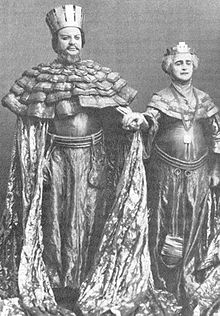Antagonist

An antagonist is a character in a story who is presented as the chief foe of the protagonist.[1]
Etymology
The English word antagonist comes from the Greek ἀνταγωνιστής – antagonistēs, "opponent, competitor, villain, enemy, rival," which is derived from anti- ("against") and agonizesthai ("to contend for a prize").[2][3]
Types
Heroes and villains
This section needs additional citations for verification. (September 2017) |
The antagonist is commonly positioned against the protagonist and their world order.[4] While most narratives will often portray the protagonist as a hero and the antagonist as a villain, like Harry Potter and Lord Voldemort in Harry Potter, the antagonist does not always appear as the villain. In some narratives, like Light Yagami and L in Death Note, the protagonist is a villain and the antagonist is an opposing hero.
Antagonists are conventionally presented as making moral choices less savory than those of protagonists. This condition is often used by an author to create conflict within a story. This is merely a convention, however. An example in which this is reversed can be seen in the character Macduff from Macbeth, who is arguably morally correct in his desire to fight the tyrant Macbeth, the protagonist.
Examples from television include J.R. Ewing (Larry Hagman) from Dallas and Alexis Colby (Joan Collins) from Dynasty. Both became breakout characters used as a device to increase their shows' ratings.
Other characters
Characters may be antagonists without being evil – they may simply be injudicious and unlikeable for the audience. In some stories, such as The Catcher in the Rye, almost every character other than the protagonist may be an antagonist.[5]
Aspects of the protagonist
An aspect or trait of the protagonist may be considered an antagonist, such as morality or indecisiveness.[5]
Non-personal
An antagonist may not always be a person or people. In some cases, an antagonist may be a force, such as a tidal wave that destroys a city; a storm that causes havoc; or even a certain area's conditions that are the root cause of a problem. An antagonist also may or may not create obstacles for the protagonist.[6]
Societal norms or other rules may also be antagonists.[5]
Usage
An antagonist is used as a plot device, to set up conflicts, obstacles, or challenges for the protagonist.[5][7] Though not every story requires an antagonist, it often is used in plays to increase the level of drama. In tragedies, antagonists are often the cause of the protagonist's main problem, or lead a group of characters against the protagonist; in comedies, they are usually responsible for involving the protagonist in comedic situations.[7]
See also
- Archenemy
- Boss, a video game term that may refer to the game's antagonist
- Villain
References
- ^ About.com, Literature: Contemporary "Antagonist." Online. 18 October 2007.
- "Protagonist and Antagonist definition". Grammarist. Retrieved 25 March 2015.
- "Glossary of Literary Terms". Archived from the original on 26 March 2015. Retrieved on 27 March 2015.
- "Glossary of Drama Terms". Online Learning Center. Retrieved on 27 March 2015.
- "Antagonist – Definition for Fiction Writers". About.com. Retrieved on 27 March 2015.
- ^ "Antagonist". Online Etymology Dictionary. Retrieved 28 November 2010.
- ^ "antagonist". Oxford English Dictionary (Online ed.). Oxford University Press. (Subscription or participating institution membership required.)
- ^ Gunderman, Hannah C. (May 2017). "Blurring the Protagonist/Antagonist Binary through a Geopolitics of Peace: Star Trek's Cardassians, Antagonists of the Alpha Quadrant". The Geographical Bulletin. 58 (1): 52–53.
- ^ a b c d Bulman, Colin (2007). Creative Writing: A Guide and/or Glossary to Fiction Writing. Polity Press. p. 17. ISBN 9780745636870 – via Google Books.
- ^ "The Elements of Literature". roanestate.edu. Archived from the original on 30 December 2017. Retrieved 29 April 2013.
- ^ a b Smiley, Sam (2005) [First published 1971 by Prentice-Hall]. Playwriting: The Structure of Action. Yale University Press. pp. 133–134. ISBN 0300107242 – via Google Books.
External links
 Media related to Antagonists at Wikimedia Commons
Media related to Antagonists at Wikimedia Commons
